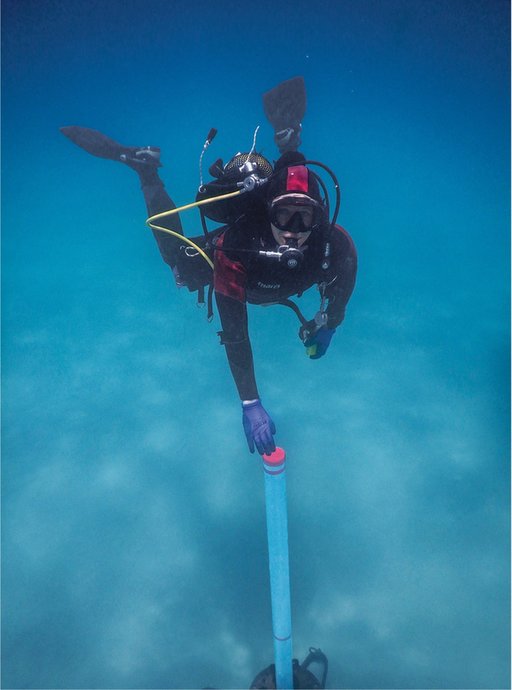Whereisyourcurrentworkfocused?
Mycurrentworkfocusesondescribingcoastlinesandlookingfortsunamidepositsallovertheworld.IcontinuetoworkintheMediterraneanandamalsosearchingalongcoastlinesofthePacificandAtlantic Oceans.
Tsunamisarelargeandpowerfuloceanwavesthatgrowinsizeastheyreachtheshore.Mostarecausedbyearthquakes.Whenthishappensunderwater,biggapsmayappearontheoceanfloor.Whenwatermovesintofillthisgap,atsunamiforms.Tsunamiscancausemajordamageastheyrushinland,flooding cities.
OneofGoodman’sareasofstudyearlyinhercareerwastheancientcoastalcityofCaesareainIsrael.ItwasbuiltbyKingHerodalmost2,000years ago.

abeachinCaesarea, Israel
underwaterruinsin Caesarea
DescribeyourfirstdiveatCaesarea.
Oneoftheexcavationleaderstookusoutforatourofthesite.Hewantedtocheckhowallofourgearwasfunctioningaswellasseehowwellwecouldhandleourselvesbeforetheexcavationsbeganafewdayslater.Iwas,byfar,theleast-experienceddiverinthegroup,soIwasverynervous.However,assoonaswedroppedintothewaterandweresurroundedbymassiveblocksofancientbuildings,IwastoodistractedbyallthethingstoseetoeventhinkaboutwhetherornotIwasagoodenough diver.
Wecruisedaroundtheancientcementblocks,nowcoveredinmarineplantsandcritters.Atonepoint,theyledusthroughaspacebetweentheblocksthatfeltlikeasmallcanyon.Itfeltalittletootight!Butattheverybottomofthatnarrowspace,ourguidefannedthesandawayfromtheblock,andwecouldseewoodthatwas2,000yearsold!Itwasworthgoingintothattight space.
Whatwereyoulookingforduringthatseasonofexcavation?
Eventhoughthereweresomewritingsthatsuggestedthattsunamishadhappenedinthepast,wedidn’thaveanyproofoftsunamisonland.Oneoftheproblemswasthatinanarchaeologicalsiteonacoastlinetheretendstobealotofsand,pottery,shell,andgravel.Guesswhatisusuallyinatsunamideposit?Thesamethings!Thismadeithardtorealizethatsomeofthoselayersinthesitewereactuallyfromatsunamieventandnotjustmaterialfrombuildingthe site.
Toconfirmtheirsuspicions,theteamlookedforevidenceoftsunamisbelowthe surface.

Goodmancollectsasedimentsampleinasmall bag.
Wecollectedevidenceusingafewdifferenttechniques.Thefirstevidencewascollectedduringunderwaterarchaeologicalexcavations.Theseexcavationsaredoneusingsomethingcalledawaterdredge,whichissortoflikeanunderwatervacuum cleaner.
Theevidencethatwefoundinthoseexcavations,andlaterincoresamples,waslayersofmaterialsthatcamefromthedeepseamixedwithmaterialsfromtheshallowseaandbeach,and materialthatcamefromtheland.Themixtureincludedpottery,shells,pebbles,microscopicorganisms,patchesofmud,andsometimesevenlargepiecesofcarvedmarble.Theonlythingthatcouldcausethiswouldbeverystrong waves.
Theteamthenlinkedthismixofmaterialwithwhattheyknewaboutthe past.
Oncewerecognizedthisevidence,welookedatthewrittenevidenceanddiscoveredthattheageofthesedepositswasthesameastheageoftheeventsweread about.
Thediscoverywasreallyimportantforprovingthatthewrittenrecordswerenotdescribingregularstormsorotherevents,butactualtsunamis.Italsotoldusthatpeoplelivingtheretodaymightneedtoprepareforatsunamihappeninginthe future.
Theteamwantedtogetafullerpictureofwhatwasunderwater.Buttheydidn’thavetherighttools.Theyneededtoinventsomethingtosolvetheir problem.
Weknewthat,ifwhatwefoundwasevidenceofanancienttsunami,thedebrisfieldshouldbeverylarge.Tofindout,weneededtotakecoresamplesusinglongpipesthatweinsertintotheseafloor.Theproblemwasthatthisisnotsoeasytodoinsandyseafloors.Youneedtoreallyhammerthepipeinalongtime,andthenyoumustremoveit somehow.
Everyoneworkedtogethertothinkabouthowwemightconnectanautomatichammertothetopofthepipetohammeritin,thenattachropesandfloatstopullitout.Ittookalotofsketching,thinking,andtrialanderroruntilwegotitright.Thefirstseason,wecollectedtwocoresin12days.Now,wecancollectthreecoresinasingle day!
Problem-solvingisreallyimportantinexploration.Sometimesyouhavetobuildthetoolthatyouneed.ThisisoneofthepartsofexplorationthatIlovethe most.

Goodmanholdssteadyapipebeingusedtotakeacoresampleofthe seabed.


